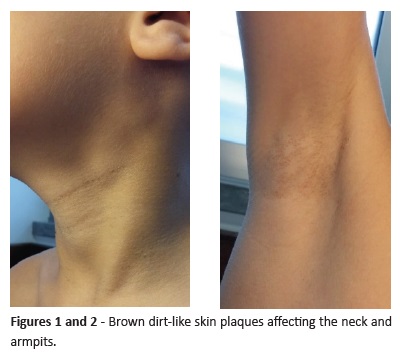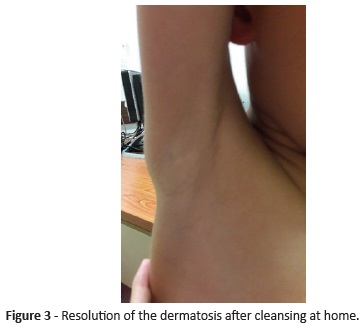Services on Demand
Journal
Article
Indicators
-
 Cited by SciELO
Cited by SciELO -
 Access statistics
Access statistics
Related links
-
 Similars in
SciELO
Similars in
SciELO
Share
Nascer e Crescer
Print version ISSN 0872-0754On-line version ISSN 2183-9417
Nascer e Crescer vol.28 no.2 Porto June 2019
https://doi.org/10.25753/BirthGrowthMJ.v28.i2.14993
WHAT IS YOUR DIAGNOSIS? | QUAL O SEU DIAGNÓSTICO?
Dermatology clinical case
Caso clínico dermatológico
Sofia PiresI, Ana Teresa GilII
I Department of Pediatrics, Hospital Pediátrico de Coimbra, Centro Hospitalar e Universitário de Coimbra. 3000-602 Coimbra, Portugal. sofia.pires88@gmail.com
II Department of Urgency, Hospital Pediátrico de Coimbra, Centro Hospitalar e Universitário de Coimbra. 3000-602 Coimbra, Portugal. ateresagil@gmail.com
Endereço para correspondência | Dirección para correspondencia | Correspondence
ABSTRACT
The case of a child with terra firma-forme dermatosis lesions is reported. This is an idiopathic and uncommon condition characterized by asymptomatic dirt-like lesions, which cannot be removed by routine cleaning. Lesions completely disappear after swabbing with 70% isopropyl alcohol. The condition is more frequent in children and often occurs on the neck, trunk, and ankles.
Keywords: Duncan’s dirty disease; keratinization disorder; terra firma-forme dermatosis
RESUMO
Os autores descrevem o caso de uma criança com dermatose terra firma-forme. Trata-se de uma doença idiopática rara, caracterizada por lesões com aspeto de sujidade, assintomáticas e que não desaparecem com a higiene de rotina. As lesões resolvem totalmente após fricção com álcool isopropílico a 70%. A condição é mais comum em crianças e aparece frequentemente no pescoço, tronco e tornozelos.
Palavras-chave: Doença de Duncan; distúrbios de queratinização; dermatose terra firma-forme
A five-year-old boy was brought to the Emergency Department due to viral pharyngitis. During clinical evaluation, the mother complained of gradually increasing, asymptomatic, brown skin plaques affecting the neck, armpits, back of the ears, and upper chest, evolving for the past six months (Figures 1 and 2). Despite good hygiene, including shower and brushing with liquid soap, the boy showed no improvement of the condition. He was otherwise healthy and the mother denied the use of any medications or creams or trauma to the involved areas. A diagnosis of terra firma-forme dermatosis was evoked. All lesions disappeared after firm rubbing with a gauze pad saturated with 70% isopropyl alcohol (Figure 3).
What is the diagnosis?
Diagnosis
Terra firma-forme dermatosis
Discussion
Terra firma-forme dermatosis (TFFD), also known as Duncan’s dirty dermatosis, is a benign condition first described by Duncan in 1987.1 The name derives from the Latin terra firma, which means dirty land. TFFD is an uncommon keratinization disorder with unknown etiology. It is proposed to occur as a result of altered melanin maturation, abnormal and delayed keratinization, and initial inadequate cleaning with build-up and compaction of scales and dirt.2,3
This condition usually manifests as asymptomatic, localized or extensive, brownish to black hyperpigmented patches or plaques, involving most commonly the neck and trunk, but also the ankles, scalp, back, limbs, and axillary, umbilical and pubic areas.4,5
TFFD affects a wide range of age groups (4 months−75 years), although it is more common in children.2,4-8
Differential diagnosis includes dermatosis neglecta, Gougerot and Carteaud`s reticular and confluent papillomatosis, acanthosis nigricans, postinflammatory hyperpigmentation, Dowling-Degos disease, and pityriasis versicolor.5,9,10
Lesions are resistant to regular washing with soap and water and may cause cosmetic concerns to patients and their families. Rubbing with isopropyl alcohol is a simple and effective treatment. Recrudescence is unusual.4 Diagnosis is clinical, with no need for unnecessary evaluations (i.e. endocrine examinations or biopsy).4,9 The authors have decided to present this case to raise awareness to TFFD. An early diagnosis made on clinical grounds can be reassuring to families and prevent unnecessary tests and treatments. TFFD should be taken into consideration for the differential diagnosis in patients with pigmentation disorders.
REFERENCES
1. DuncanWC, Tschen JA, Knox JM. Terra firma-forme dermatosis. Arch Dermatol 1987; 123:567-9. [ Links ]
2. Santarpia M, Guarneri C. Terra firma-forme dermatosis. Eur J Intern Med. 2016; 34:e1-2. [ Links ]
3. Solak B, Erdem T. Terra firma-forme dermatosis: wipe first. Int J Dermatol. 2015; 54:e548-9. [ Links ]
4. Berk DR. Terra firma-forme dermatosis: a retrospective review of 31 patients. Pediatr. Dermatol. 2012; 29:297-300. [ Links ]
5. Akkash L, Badran D, Al-Omari AQ. Terra firma forme dermatosis. Case series and review of the literature. J Dtsch Dermatol Ges 2009; 7:102-7. [ Links ]
6. Berk DR, Bruckner AL. Terra firma-forme dermatosis in a 4-month-old girl. Pediatr Dermatol. 2011; 28:79-81. [ Links ]
7. Guarneri C, Guarneri F, Cannavò SP. Terra firma-forme dermatosis. Int J Dermatol. 2008; 47:482-4. [ Links ]
8. Ratcliffe A. Williamson D, Hesseling M. Terra firma-forme dermatosis: it`s easy when you know it. Arch Dis Child. 2013; 98:520. [ Links ]
9. Gusdorf L, Cribier B. Clinicopathological aspects of terra firma- forme dermatosis. Ann Dermatol Venereol. 2016; 143:446-52. [ Links ]
10. Meseguer-Yebra C, Meseguer-Yebra P, Garrido-Rios AA, Sánchez Estella J. Terra firma-forme dermatosis. Na Pediatr (Barc). 2015; 82:e222-3. [ Links ]
Endereço para correspondência | Dirección para correspondencia | Correspondence
Sofia Pires
Department of Pediatrics, Hospital Pediátrico de Coimbra
Centro Hospitalar e Universitário de Coimbra Avenida Dr. Afonso Romão, Alta da Baleia, 3000-602 Coimbra
Email: sofia.pires88@gmail.com
Received for publication:08.10.2018
Accepted in revised form: 11.01.2019
















